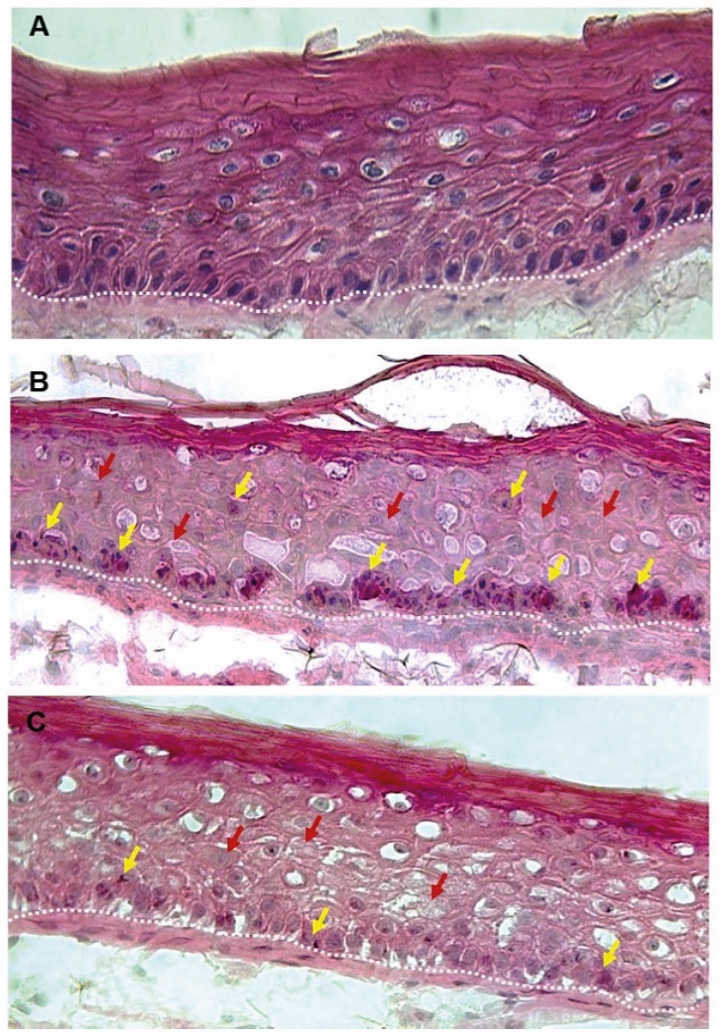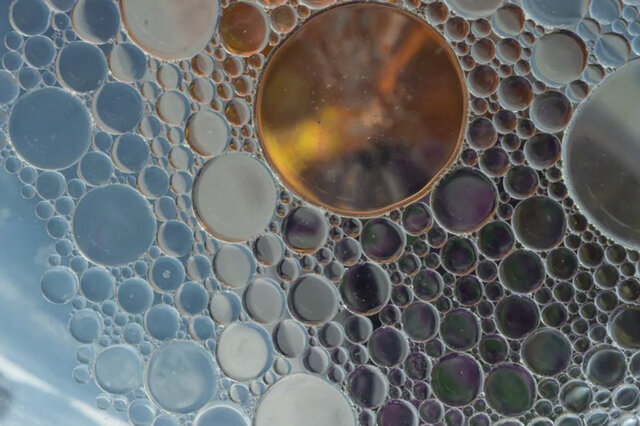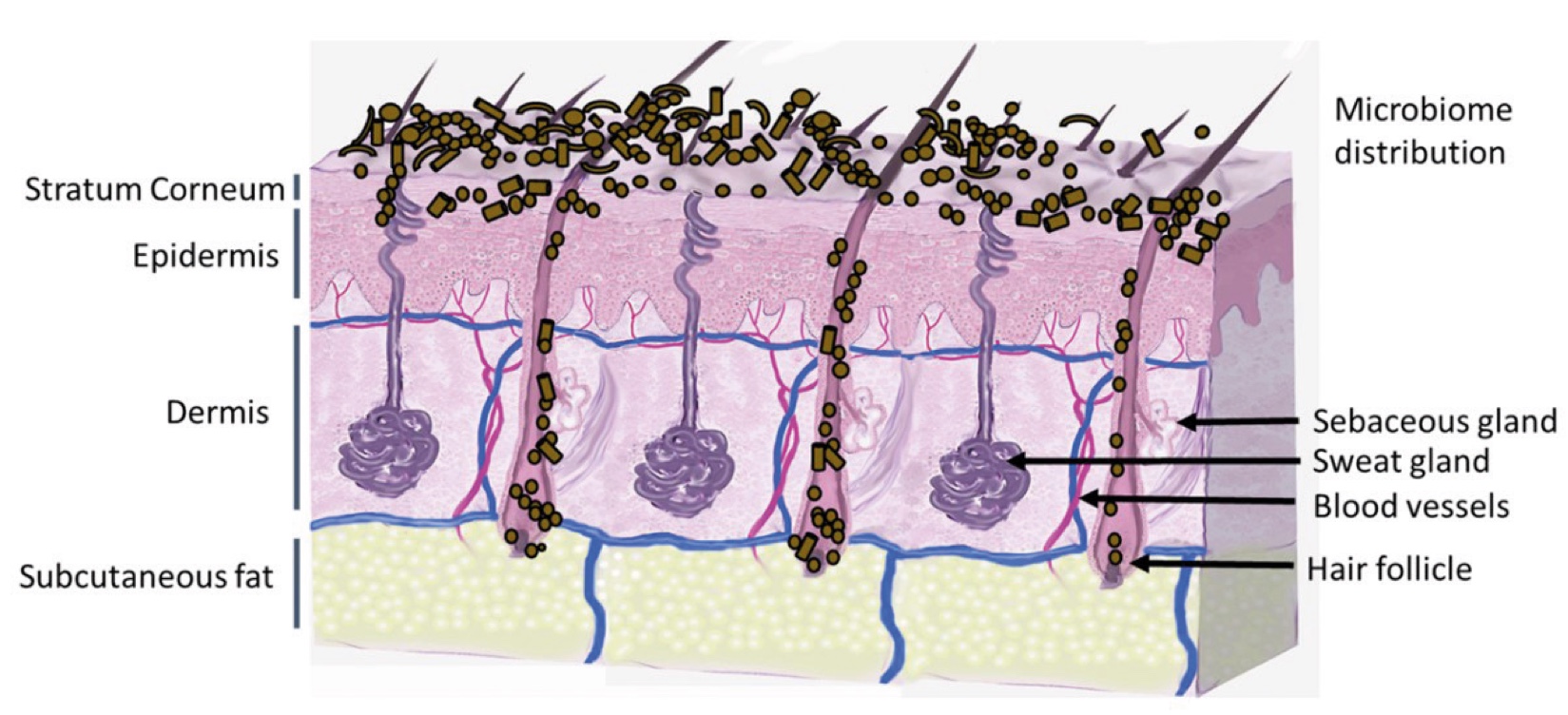Field Notes from the 2024 82nd Annual Meeting of the American Academy of Dermatology Meeting
??????????????????
“
“A study in healthy women providing probiotic yogurt for four weeks showed an improvement in emotional responses as measured by brain scans”

Figure 1. Skin Section with Microbiome. Most microorganisms live in the superficial layers of the stratum corneum and in the upper parts of the hair follicles. Some reside in the deeper areas of the hair follicles and are beyond the reach of ordinary disinfection procedures. There bacteria are a reservoir for recolonization after the surface bacteria are removed.
Materials and methods
Studies of major depressive disorder have been correlated with reduced Lactobacillus and Bifidobacteria and symptom severity has been correlated to changes in Firmicutes, Actinobacteria, and Bacteriodes. Gut microbiota that contain more butyrate producers have been correlated with improved quality of life (1).
A study in healthy women providing probiotic yogurt for four weeks showed an improvement in emotional responses as measured by brain scans (2). A subsequent study by Mohammadi et al. (3) investigated the impacts of probiotic yogurt and probiotic capsules over 6 weeks and found a significant improvement in depression-anxiety-stress scores in subjects taking the specific strains of probiotics contained in the yogurt or capsules. Other studies with probiotics have indicated improvements in depression scores, anxiety, postpartum depression and mood rating in an elderly population (4-7).
Other studies have indicated a benefit of probiotic supplementation in alleviating symptoms of stress. In particular, researchers have looked at stress in students as they prepared for exams, while also evaluating other health indicators such as flu and cold symptoms (1). In healthy people, there is an indication that probiotic supplementation may help to maintain memory function under conditions of acute stress.
OVERVIEW
Over 19,809 dermatologists and others interested in the field of dermatology attended the meeting March 8-12 in San Diego, California, USA. This event is the world’s largest dermatology meeting.
PLENARY SESSION
The plenary provided attendees the opportunity to hear from renowned experts on topics that impact dermatologists and their patients. It is the opportunity to present advances in health care concerns and changes in educational delivery tools as well. Below are topics of interest for both dermatologists and professionals in the cosmetics industry.
Photodermatology: past, present and future
Henry W. Lim, MD, FAAD
Dept of Dermatology, Henry Ford Health Detroit, Michigan, USA
Dr. Lim gave the Clarence S. Livingood, MD Memorial Award and Lectureship: “Photodermatology: Past, Present and Future”
Dr. Lim reviewed the history of photodermatology and the photobiology as related to skin. He started his presentation with the description of visible light as observed by Sir Isaac Newton in 1669. Dr. Lim detailed the progress made in phototherapy, photodermatoses, and photoprotection through the ages. He started with Isaac Newton’s discovery in 1665 that a prism bends visible light and that each color refracts at a slightly different angle depending on the wavelength of the color. In 1903 Niels Finsen received the Nobel Prize for his therapeutic results using ultraviolet radiation to treat lupus vulgaris. This marked the start of modern phototherapy. Although ultraviolet (UV) therapy is used for a varied of skin conditions, long-term exposure to UV radiation from sunlight can cause premature skin aging (photoaging) resulting in wrinkles, altered pigmentation, and loss of skin tone. Dr. Lim along with collaborators investigated the role of matrix-degrading metalloproteinases, a family of proteolytic enzymes, as mediators of collagen damage in photoaging. In other words, confirming that UV exposure promotes skin photoaging (1). Dr. Lim went on to study the difference between photoaging presentation in dark skin and light skin when exposed to visible light and UVA 1 on conditions aggravated by sun exposure. In recent years studies have shown the negative impact of visible light on skin health, particularly for people of color (2). Regarding future application of phototherapy, Dr. Lim advised potential use of photobiomodulation, a non-invasive form of phototherapy red light wavelength a portion of visible light spectrum, and near infrared have potential to be used to treat radiation dermatitis, acne, skin rejuvenation, wounds, and scars. Infrared radiation (IR) is under evaluation for hair restoration. Further, new knowledge is being gained understanding the biologic effects of electromagnetic radiation beyond the UV spectrum, i.e., visible light /IR and interactions with exposome and the microbiome.
Lectureship Title: Sensing Inflammation At The Barrier
Brian Kim, MD, FAAD, Professor and Vice Chair of Research in the Department of Dermatology at the Icahn School of Medicine at Mount Sinai, New York, USA
Dr. Kim is a leading researcher in the study of patients with itch and other skin conditions focusing on mechanisms that control neuroimmune interactions at the skin barrier surface. His goal is to understand the regulatory mechanisms that control neuroimmune interactions at the skin barrier surface and how immune responses interface with the sensory nervous system to regulate inflammation, sensation, and immunity. Dr. Kim is a pioneering researcher studying cytokine biology, the communication between the immune system and the nervous system and how the immune system relays sensations back to the brain and regulates organ physiology and immune response. The discovery of itch-specific receptors and associated pathways that signal itch sensations is advancing the knowledge in how these pathways suppress itch. A recent paradigm shift is that in the past itch was not viewed as a disease, rather a symptom of a primary disorder. Currently the thought is that itch can be relieved in the absence of controlling the causing disease. An example are the opioid receptor-targeting agents are leading the way to advance development of new treatments and are providing increased insight in understanding itch biology. Opioid receptors are found in different cell types, they are well-known for their function on neurons. Endorphins bind to mu-opioid receptors (MORs) activation of this pathway is found to be very effective to alleviating pain. Activation of MOR can potentially stimulate or intensify the sensation of itch. On the other hand, another opioid receptor, the kappa-opioid (KOR) activates sensory neurons to suppress both pain and itch. These observations have helped to clarify the peripheral and central pathways that promote itch sensations and have generated heightened interest in further studies to understand the mechanism of itch suppression, via MOR and KOR receptor pathways (3, 4, 5, 6).

A DERMATOLOGICAL FOCUS ON THE SCIENCE OF COSMECEUTICALS AND NUTRACEUTICALS
Zoe Draelos MD, Dermatology Consulting Services, Consulting Professor, Department of Dermatology, Duke University School of Medicine, North Carolina, USA
Dr. Draelos was session chair for The Science of Cosmeceutical and Nutraceuticals which was well-attended. The session reviewed the science surrounding topicals and oral ingredients claimed to enhance the appearance of skin. Topical skin care ingredients discussed included peptides, exosomes, growth factors, and DNA repair agents that were assessed for their value in skin care regimens. The aim of the session was to aid the attendee in assessing the current state of cosmeceutical and nutraceutical science.
Skin of Color Needs
Dr. Draelos gave the initial presentation addressing skin of color needs. The skin barrier of people of color when evaluated for transepidermal water loss is higher than Caucasian skin, indicating a more fragile barrier and a tendency for sensitive skin. However, when skin hydration is measured using corneometry, a method based on the principle that water within the skin conducts electricity, skin conductance is higher in African American and Hispanic persons, indicating that compared to Caucasian skin, they have a higher water content. Regarding lipid content, skin of color has a higher lipid content compared to Caucasian skin, ceramide content is about 50% lower compared to Caucasian and Hispanic skin. The ration ratio of cholesterol: fatty acid is also different in African American skin. The stratum corneum (SC) is more compact in African American, SC is 20 layers compared to 16 layers in Caucasian skin. African American SC has 2.5 times greater desquamation compared to Caucasian skin. The dermis of African American skin is thicker than Caucasian skin and is more resistant to effects of photodamage and aging. With respect to pigmentation, African American (AA) skin contains more eumelanin, the darker form of melanin and Caucasian skin contains higher levels of pheomelanin. The pH of African melanocytes is neutral and Caucasian melanosomes is acidic, tyrosinase, an enzyme responsible for melanin production is more active at neutral pH. There is also a higher melanosome transfer to keratinocytes in AA skin compared to Caucasian skin. Numerous pigment(s) brightening ingredients are available in the marketplace. They include hydroquinone, kojic acid, retinol, Vitamin C; these ingredients may be too irritating for skin of color, other ingredients with less irritation potential include niacinamide, azelaic acid, silymarin, arbutin and tranexamic acid. All skin types need sun protection. AA skin can benefit from tinted sunscreens that can protect against dyspigmentation associated with exposure to visible light. Black, yellow, and red iron oxide colorants combined with tinted titanium dioxide can be added to inorganic sunscreens to block UV and visible light while providing suitable color enhancing capability and minimizing the undesirable white cast on darker skin (7).
Late Breaking Cosmeceuticals 2024
Joshua Zeichner, MD, Associate Professor of Dermatology, Icahn School of Medicine at Mount Saini, New York, NY, USA
Dr. Zeichner discussed a novel multi-weight hyaluronic acid plus antioxidant complex. Hyaluronic acid (HA) is found in the extracellular matrix of skin. It functions as a humectant that can bind 1,000 times its mass with water. HA concentration and synthesis decreases in aging skin. Reactive oxygen species and other free radicals degrade HA. Dr. Zeichner presented data showing that an HA complex with the antioxidant glycine saponin induced endogenous HA synthesis in fibroblasts and decreased the degradation rate of HA by 54%. Another ingredient, acetyl dipeptide cetyl ester was shown to reduce irritation in skin and protect collagen-making fibroblast cells. Acetyl dipeptide-1 cetyl ester is a lab-engineered synthetic peptide that combines acetic acid and cetyl alcohol with dipeptide-1. The dipeptide is found naturally in the body and is composed of amino acids arginine and tyrosine. It helps to maintain the skin’s elasticity and can be considered an anti-glycation agent (8). Dr. Zeichner discussed lotus sprout extract (Nelumbo nucifera) as an effective skin brightening agent. It possesses antioxidant, anti-inflammatory, and soothing properties. Dr. Zeichner reported on the skin brightening effects of the lotus sprout extract showing exceptional potential to improve the appearance of skin (9).
Senescence Concepts and Cosmeceuticals 2024
Edward L. Lain, MD, FAAD, Chief Medical Officer, Sanova Dermatology, Austin, Texas, USA
Senolytics is relatively new approach that targets and removes senescent cells in skin to “treat” aging. Senescent cells are commonly referred to as zombie cells, accumulate over time causing inflammatory reactions and promoting skin aging. Dr. Lain explained that the immune system usually clears senescent cells, however when many are present at once or constantly produced by oxidative stress over time, they accumulate in skin. In this situation they induce inflammation and cause other cells to become senescent. The aging process increases dysfunction of the innate and adaptive immune response. This is referred to as immunosenescence, one can observe an increase in the number of memory T cells to respond to lingering levels of low-grade inflammation and can result in immune dysfunction, this condition is also referred to as inflammaging. Melanocytes, the pigment producing cells in skin are subject to senescence from prolonged exposure to Ultraviolet light and via DNA damage drive cells into senescence, and detrimental to skin. Dr. Lain reported on studies that provide a proof of concept that senescent melanocytes affect keratinocyte function and act as drivers of skin aging. Senolytic agents can rescue the surrounding cells to act as anti-aging agents by eliminating accumulation of senescent cells (10). Quercetin is an example of a natural ingredient that has this potential.
Conclusion
The future of cosmetics lies in the continued evolution of holistic approaches which represents a transformative shift in the industry, merging scientific advancements, natural ingredients, and wellness principles. By understanding and embracing the interconnectedness of these elements, the cosmetics industry can cultivate products that not only enhance external beauty but also contribute to the overall well-being of individuals and the planet.
The interplay between beauty from within and topical cosmetics is the key for future products. The integration of biotechnology and green chemistry is revolutionizing cosmetic formulations, offering sustainable and biocompatible alternatives.
Developers can implement blockchain to trace the journey of ingredients from source to product. Nevertheless, the efficacy of the natural products should be scientifically proven. Marketers can communicate transparency as a brand value, and parallelly educate consumers by highlighting how specific ingredients contribute to radiant and healthy skin.
By embracing the synergy between these approaches and leveraging scientific advancements, the cosmetics industry can provide consumers with comprehensive beauty solutions that cater to both internal and external dimensions of beauty.
Surfactant Applications

The application area lends itself particularly well to the use of AI. Active today in this area is the US company Potion AI (6). The company provides AI-powered formulation tools for beauty and personal care R&D. Their offerings include Potion GPT, next generation ingredient and formula databases and AI document processing. Potion’s work could have a significant impact on the entire surfactant value chain, from raw material suppliers to end consumers. By using their GPT technology, they can help target work toward novel surfactant molecules that have optimal properties for specific applications. By using their ingredient and formula databases, they can access and analyze a vast amount of data on surfactant performance, safety, and sustainability. By using their AI document processing, they can extract and organize relevant information from patents, scientific papers, and regulatory documents. These capabilities could enable Potion AI's customers to design and optimize surfactant formulations that are more effective, eco-friendly, and cost-efficient. A particularly interesting application for this type of capability is deformulation.
Deformulation is the process of reverse engineering a product's formulation by identifying and quantifying its ingredients. Deformulation can be used for various purposes, such as quality control, competitive analysis, patent infringement, or product improvement. However, deformulation can be challenging, time-consuming, and costly, as it requires sophisticated analytical techniques, expert knowledge, and access to large databases of ingredients and formulas.
AI can potentially enhance and simplify the deformulation process by using data-driven methods to infer the composition and structure of a product from its properties and performance. For example, AI can use machine learning to learn the relationships between ingredients and their effects on the product's characteristics, such as color, texture, fragrance, stability, or efficacy. AI can also use natural language processing to extract and analyze information from various sources, such as labels, patents, literature, or online reviews, to identify the possible ingredients and their concentrations in a product.

Figure 2. Skin Section with Microbiome. Most microorganisms live in the superficial layers of the stratum corneum and in the upper parts of the hair follicles. Some reside in the deeper areas of the hair follicles and are beyond the reach of ordinary disinfection procedures. There bacteria are a reservoir for recolonization after the surface bacteria are removed.
References and notes
- Fisher GK, Wang ZQ, Datta SC, et al., Pathophysiology of premature skin aging induced by Ultraviolet light. N Engl J Med., 1997 Nov 13;337(20): 1419-28. https://pubmed.ncbi.nlm.nih.gov/9358139/
- Taylor SC, Alexis AF, Armstrong AW, et al., Misconceptions of photoprotection in skin of color, J Am Acad Dermatol., 2022 Mar;86(3S):S9-S17. https://pubmed.ncbi.nlm.nih.gov/34942293/
- Tseng PY, Hoon MA, Oncostatin M can sensitize sensory neurons in inflammatory pruritis. Sci 4 Translational Med. 2021, 13(619) abe3037. https://pubmed.ncbi.nlm.nih.gov/34757808/
- Kim BS, The translational revolution of itch. Neuron. 2022, 110(14): 2209-2214. https://pubmed.ncbi.nlm.nih.gov/35447089/
- Drissi I et al., Understanding the genetic basis of congenital insensitivity to pain. Br Med Bulletin. 2020, 133(1): 65-78. https://pubmed.ncbi.nlm.nih.gov/32219415/
- Nguyen E et al., Medullary Kappa-Opioid receptor neurons inhibit pain and itch through a desending circuit. Brain. 2022, 145(7): 2586-2601. https://pubmed.ncbi.nlm.nih.gov/35598161/
- https://www.zoedraelos.com/articles/#main. Accessed March 28, 2024.
- Schoelerman AM, Jung KA, Buck B et al., Comparison od skin calming effects of cosmetic products containing 4-t-butycyclohexanol or acetyl dipeptide-1 cetyl ester on capsaicin-induced facial stinging in volunteers with sensitive skin. J Eur Acad Dermatol Venerol. 2016, Feb:30: Suppl 1:18-20. https://pubmed.ncbi.nlm.nih.gov/26805418/
- Moon SH, Kim E, Kim H-I, et al., Skin-whitening effect of a callus extract of Nelumbo nucifera isolate haman. Plants. 2023, 12(23): 3923. https://pubmed.ncbi.nlm.nih.gov/38068559/
- Low E, Alimohammadiha G, Smith LA, Costello LF, Przyborski SA, von Zglinicki T, Miwa S. How good is the evidence that cellular senescence causes skin ageing? Ageing Res Rev. 2021, Nov;71:101456. https://www.ncbi.nlm.nih.gov/pmc/articles/PMC8524668/



